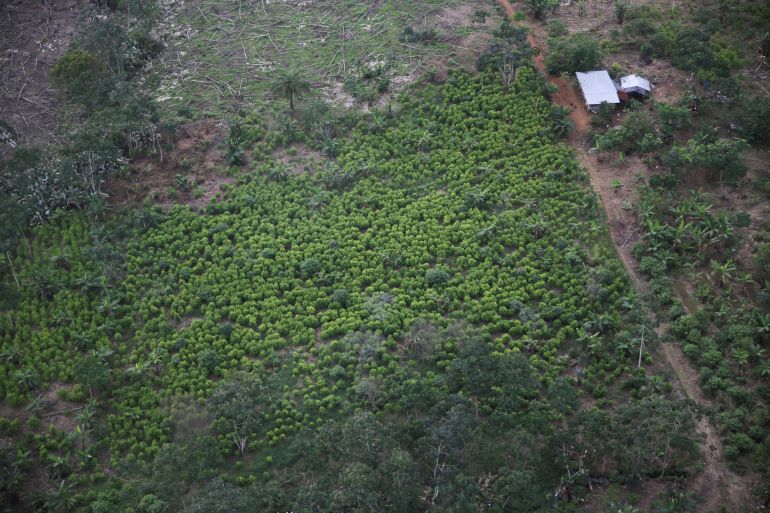Colombia’s coca crops grew to ‘historic levels’ last year: UN
Cultivation of the plant from which cocaine is made threatens Colombia’s ‘cultural potential, biodiversity’, UN agency says.

Colombian lands planted with coca, the plant from which cocaine is made, reached their highest levels in two decades last year, a United Nations agency has said in an annual report.
The UN Office on Drugs and Crime (UNODC) said on Thursday that the area growing coca in Colombia shot up 43 percent from 2020, to 204,000 hectares (500,000 acres) in 2021.
Keep reading
list of 3 itemsOtoniel shipped ‘outrageous’ amounts of cocaine to US: Prosecutor
Land or Death: Colombia’s Indigenous Land Wars
Potential cocaine production also reached record levels last year at 1,400 tonnes, up 14 percent from 2020, the agency said.
That continued an upward production trend that dates back to 2014 while the uptick in the area planted with coca was the first in three years.
“This is the highest figures in our 22 years of monitoring,” UNODC Andean and Southern Cone regional director Candice Welsh told reporters.
She urged Bogota to improve security for communities transitioning to legal crops and increase social spending.
Colombia has long been the world’s largest producer of cocaine, a highly addictive drug that is illegal in most countries, and it has faced pressure, notably from the United States, to crack down on production.
In 2021 the illicit #CocaCrops reached historic levels in #Colombia 🇨🇴 and broke the trend of reduction that had been occurring in the last three years.
🟢 Check out the results of the latest report conducted by @UNODCROCOL 👉 https://t.co/Ax9NoTklKC pic.twitter.com/zqqpnnJEOo
— UN Office on Drugs & Crime (@UNODC) October 20, 2022
But government efforts to get farmers to move away from illegal coca crops have faced a series of challenges, including a lack of promised subsidies and other incentives.
Many poor Colombians involved in coca farming say they have no other choice.
Colombia’s new left-wing president, Gustavo Petro, who has called the war on drugs “irrational”, has proposed regulating narcotics, expanding voluntary crop substitution programmes, focusing enforcement on drug gang leadership and increasing social funding in production areas.
On Thursday, Justice Minister Nestor Osuna said the reported increases came despite the eradication of about 440,000 hectares (1.09 million acres) of coca in recent years.
“If we want to revert these figures, we need to do something different,” Osuna said, adding that a 2016 peace deal with rebels from the Revolutionary Armed Forces of Colombia (FARC) includes crop substitution provisions that must be followed.
Increases in output are due to more productive coca varieties, better technical assistance and the replanting of coca bushes, the UNODC report said.
“Coca cultivation continues to threaten the cultural potential of the country and its biodiversity,” the agency said in a statement.
“About 50 percent of the coca is located in special management areas,” it said. “A high percentage is concentrated on the lands of Black communities and in forest reserve areas.”